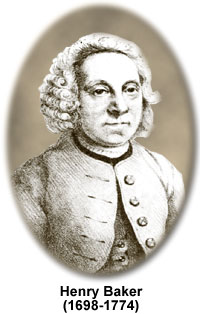Henry Baker
(1698-1774)

Born in London on May 8, 1698, Henry Baker was a significant contributor to the popularization of microscopy and the dissemination of scientific knowledge. During his younger years, he served as an apprentice to a bookseller and later made his fortune by devising and practicing a system to teach hearing and speech impaired children. Baker's achievements were noticed by the writer Daniel Defoe and inspired his novel The History of the Life and Adventures of Duncan Campbell, the title character of which is a deaf conjurer. Defoe's youngest daughter, Sophia, was also intrigued by Baker and the couple married in 1729.
Having attained wealth early in his life, Baker was left with ample time to pursue his many interests. Perhaps influenced by his father-in-law, Baker was often involved in the arts and was a writer and translator of poetry. He was also connected with Defoe in the launching of the publication The Universal Spectator and Weekly Journal and was a founder of the Society of the Arts, established in 1754.
Simultaneously a fellow of the Society of Antiquaries and the Royal Society, Baker was a naturalist whose microscopical observations of aquatic animals and fossils were of interest to a wide audience. In 1744, his study of crystal morphology garnered Baker the Copley Gold Medal for his microscopical work and inspired other scientists to engage in systematic microscopic studies of crystalline formations. Many of the materials he examined were observed through a compound microscope made by the English optics expert John Cuff (1708-1772), which he designed at Baker's behest.
Baker published two books on microscopy, The Microscope Made Easy (1742) and Employment for the Microscope (1753), that were extremely popular throughout the eighteenth century. In fact, The Microscope Made Easy had run through five editions by 1769, and both were translated into French and Dutch. Continually enthralled with the wonders of the universe revealed through a microscope, Baker spent many years of his life dedicated to instilling the same reverence in others. In The Microscope Made Easy, he writes:
"The works of nature are the only source of true knowledge, and the study of them the most noble employment of the mind of man.... Microscopes furnish us as it were with a new sense, unfolding the amazing operations of nature, and presenting us with wonders unthought of by former ages."
Dying in London on his 76th birthday, Baker's vision was perpetuated by those whom he first inspired to look through a microscope, as well as their successors. The Royal Society continues to sponsor a Bakerian lecture each year in his honor, the foundation of which was initially established by a bequest of money made by Baker in his will.
